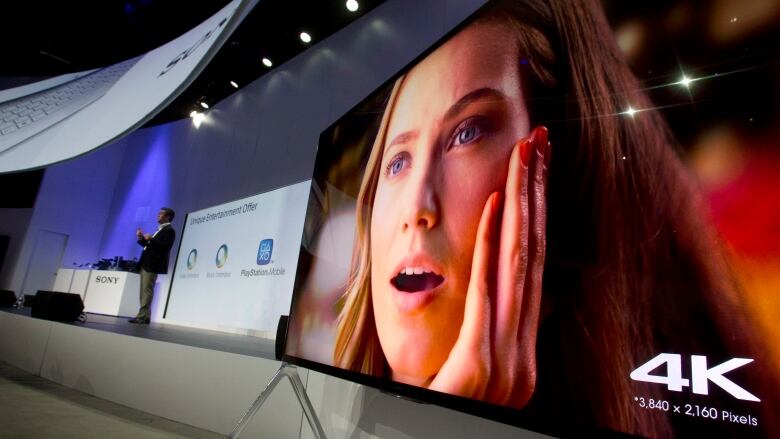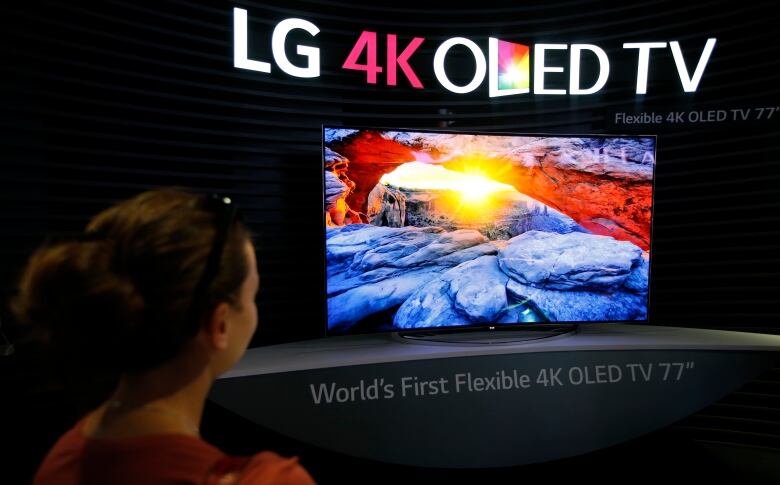4K TV: What you need to know
Rogers, TSN offering live sports broadcasts in enhanced resolution as 4K technology gains momentum

No longer the purview of early adopters and technology aficionados, 4K TVs are going mainstream.
- Rogers announces Ignite Gigabit internet, 4K sports broadcasts
- The 10 hottest new tech products from CES 2016
- Apple releases new iMacs with Retina displays
Withsalespicking up as prices drop,4K TVs andBlu-rayplayerswere on display in full force at theConsumer Electronics Show in Las Vegas earlier this month.AndCanada's big cable companies are catching up tostreaming services by increasinglyoffering 4Kcontent.
Rogers has announced it will be broadcasting the first-ever NHL game in 4K this Saturday the Toronto Maple Leafs versus the Montreal Canadiens.
"4K is pretty much the standard now. This is what everybody will be using for the rest of the year continuing forward,"AdrianBulzacki, founder of interactive video softwarecompany ARB Labs,told CBC News.
But before you rush out to buy a 4K television, here's what you need to know.
What is 4K?
Despite the streams of techno-babble and acronymsthat seem to make up every4K product descriptionIt's incomprehensible, so it must be top of the line!4K is a pretty straightforward concept.
It means more pixels. That's it.
Pixels are the tiny dots that make up on-screen images. The more of them you have, the sharper the picture.
Imagine your TV as a grid.Astandard HD displayhas a resolution of1,920by 1,080 that's1,080 rowsand 1,920 columnsof pixels.4K, by contrast, is usually3,840by2,160.
It's called 4K because it'salmost 4,000 pixels wide, and 3.84Kjust doesn't have the same ring to it.
You'll also sometimes hear it referred to as ultra-high definition, or UHD.
Will you notice a difference?
It depends.
In a press release for itsupcoming hockey broadcastRogers promisesyou'll be able to see"theflex of the stick and the grooves in the ice."
But setting aside the fact that you might not want, or need,this level of detail,you might not be able to perceive the difference,anyway.(When's the last time you thought:"That was a very compelling episode ofBreaking Bad, but I wish could have seen Walter White's nosehairs more clearly?")

The human eye has a finite resolution. You can see individual blades of grass and grains of sand up close, but not off in the distance.
Similarly, to really get anything out of a 4K TV, you need a big screen:48 inches at the very least, and you have to sitclose to it. To get an idea of whether it makes sense to have one in your living room, check out this Associated Press interactive.
What can you watch?
Just having a 4K TV isn't enough you have to be watching 4K content. A year ago, that was hard to come by, but that's rapidly changing.
Streaming
Streaming services have been the earliest adopters of 4K. YouTube has had itsince 2010, and Netflix offers almost all of its in-house content in 4K if you upgrade to an$11.99 per month package. So you can get really up close and personal with Kevin Spacey during those intimateHouse of Cards monologues.

Canadian streamingservices are catchingup, too.
Shomi, the streaming video partnership between Rogers and Shaw, will offer more than 100 hours of 4K entertainment, though a timeline for that rollout hasn't been announced. Bell's Discovery Go streaming video service on Samsung's Ultra HD TVs also has a lineup of 4K titles.
Just remember, you'll need a fast internet connection handle all those sweet, sweet pixels. Netflix recommends at least25 megabits per second.
Television
Cable providers are getting excited about 4K Rogers' president of media business, Rick Brace, recently called it"a revolution" and they're pushing out the content to matchtheir enthusiasm.Especially sports.
After theNHL's 4K debut on Saturday,Rogers has committed to 4K resolution on Sportsnet for another 19 NHL games, as well as81 Toronto Blue Jays home games.Bellbroadcast a Toronto Raptors home game in 4Kon Jan. 20 and promises more4K programming on its TSN channels laterthis year.

Still, most cable TV favourites won't be offered in 4K this year, so if you're not a big sports fan and you don't stream, you might want to hold off on purchasing a 4K TV.
Home movies
You can also catch some Hollywood movies on special Blu-ray discs re-mastered in 4K, but in addition to the TV, you'll require a 4K Blu-ray player, which costs around $150.
How expensive are they?
In 2012, you would have shelled out upwardof $7,500for a 4K TV. Now, basic models start between$700 and$1,000.That's what Bulzacki calls "thesweet spot for TVs."
"Thousands and thousands of dollars is a huge premium, and that premium seems to be gone now,"he said.
What's next?
HDR
Another buzzword you'll hear a lot in 2016 is HDR,which stands for high dynamic range. (Tech folksjust love their acronyms and abbreviations.) While 4K offers more pixels, "HDR significantly expands the range of contrast and colour that those pixels can show," explains David Katzmaier at CNET.
A lot of 4K technology rolling out in 2016 will also be HDR-enabled.
OLED
OLED,which stands for organiclight-emitting diode, is another technology that enhancescolour display.The only screen that doesn't use backlight,OLED TVs are particularly thin and energy efficient, and they show colour with intense vibrancy.

4K OLED TVs are on the market now, but thecheapest option will set you back more than$2,000.
Virtual reality
Bulzackipredicts 4K will one day push virtual reality to the next level.
- Oculus Rift virtual reality headset pre-orders open
- Virtual reality may not be ready for prime time just yet
"We're going to be dumbfounded when we get intothings likeOculusRift," he said. "That's not a 4Kdevice, but once you start seeing 4Kquality inheadgear, it's going to become extremely lifelike."












_(720p).jpg)


 OFFICIAL HD MUSIC VIDEO.jpg)
.jpg)



























































































